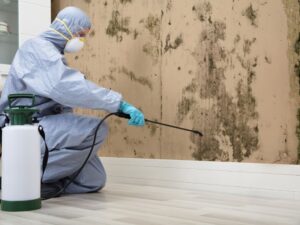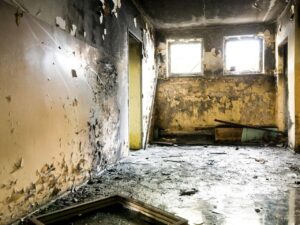Services
Fire damage cleanup Bronx is a multi-step, challenging process that often includes addressing water damage, fire damage, and smoke damage.
Cleaning Up After Fire Damage
Cleaning up after fire damage is a massive undertaking, which takes considerable time and effort to complete. After a severe fire, fire professionals may tell homeowners to board-up their house until experienced professionals have made it safe.
But even with more minor fires, homeowners should work alongside fire damage restoration experts to safely clean up their property. Homeowners who participate in the fire damage cleanup process must take precautions to keep themselves safe.
Anyone cleaning up after a fire needs the following PPE:
While healthy, able individuals may want to clean up their own home after a fire, certain people should not participate. Seniors, children, pregnant women and people with pre-existing health conditions should steer clear of fire damage repair and leave the work to professionals.
Homes with additional hazards, such as asbestos, lead paint or mold, need to be cleaned up by a restoration company with experience in both fire damage and hazardous materials.
Types of Fire Damage
While fire itself can cause immense damage, it’s not the only cause of damage during a fire. Soot, smoke and water damage are also significant concerns.
Soot stains upholstery, carpeting and other belongings, while smoke odor can permanently ruin precious possessions. Water from fire suppression efforts causes damage to the property, and water damage progressively worsens until all the water is removed correctly.
Water Damage
Water damage often occurs after a fire due to the copious amounts of water used in sprinkler systems and firefighting efforts. This water must be adequately cleaned up to salvage as much of your property as possible, and prevent health and safety issues.
After a fire, homeowners or water damage restoration technicians need to remove any standing water and then sort through waterlogged possessions. Salvageable belongings should be saved, while those that are too damaged need to be disposed of properly.
The property then needs to be dried out using professional-grade dehumidifiers, air movers and water-extraction equipment. Once dry, every affected area of the home needs to be thoroughly cleaned to prevent mold growth.
Homeowners are welcome to take on many of these tasks on their own but should work directly with fire and water damage specialists during water removal and cleaning.
Smoke Damage
Smoke seeps into every surface during a fire and lingers, resulting in damage that often goes unseen. Smoke damage cleanup is an essential step in the fire restoration process and should not be skipped.
Smoke damage can lead to health issues, as fine particles can get into the body and aggravate internal organs. Smoke particles are particularly dangerous to older adults, people with diabetes, heart or lung disease, children and pregnant women.
Soot damage often coincides with smoke damage and should be removed by an experienced fabric cleaning technician, if possible. Rubbing or touching soot can cause oily stains to permanently set in upholstery, curtains, carpets and other fabrics.
Many soot and smoke damaged belongings can be salvaged with proper cleaning techniques. Chemicals and commercial cleaning products are available to help remove soot and smoke from your home, and deodorization products can also help with odor removal.
When it comes to your most precious or expensive belongings, professional restoration services are always recommended.
Property Damage
Fires can cause a devastating amount of property damage in a short period. The extent of this damage depends on the fire type and location, and the speed of emergency response teams.
Homeowners should hire a fire remediation specialist to complete a fire damage assessment before doing any cleanup. These specialists will help homeowners develop a plan of action for recovering as much property as possible, while preventing any further damage.
Once a plan is in place, homeowners can work with the fire damage restoration technicians to minimize the cost and efforts involved with cleanup. Typically, fire restoration technicians will need to take care of structural damage and hazardous material cleanup.
At the same time, homeowners can help with smaller tasks like scrubbing walls, floors and furniture, washing clothing and sorting personal belongings.
Homeowners with health conditions or individuals who are uncomfortable with a DIY approach are encouraged to hire fire damage restoration services to complete the entire property damage cleanup.
Fire Damage Cleanup Timeline
Fire damage cleanup requires time and extensive effort because of the numerous steps involved. Professional teams can clean up small fires within a few days, but larger fires may require months.
The typical fire damage restoration process includes the following steps:
Each of these steps takes time and care to perform correctly. Homeowners should be prepared for a temporary but immediate board-up of their home and find an alternative place to stay during the fire cleanup process, which can take 1-3 months or longer.
Soot removal, water damage and chemical contamination are usually the most expensive aspects of fire damage repair, while the removal of smoke and odors is the least costly.
Most homeowners insurance policies cover fire and smoke damage, at least to an extent. However, it’s critical to contact your insurance company to understand your coverage and start the claims process before any cleanup begins.
Get Help From Fire Clean Up Services
Fire clean up services can ease the stress and burden of cleaning up your home after a fire. Professionals in the restoration industry are devoted to helping homeowners return to everyday living by cleaning fire, smoke, soot and water damage.
Most fire damage restoration companies offer 24/7 emergency services and use state-of-the-art equipment to help save your property and possessions. These professionals also know how to clean salvageable building materials and possessions, preventing any further damage after the fire.
Homeowners are encouraged to ask for testimonials when hiring fire and smoke restoration technicians in their community. Trusted leaders in the restoration industry will have case studies and examples of how they helped clients with fire damage cleanup.

Mold is a microscopic life form found in all parts of the world and is part of the natural decomposition of organic materials. Mold requires three things to grow: nutrients.

Mold remediation is taking action to reduce, isolate, or remove contamination from an environment with the goal of preventing further reproduction and spreading.

Mycotoxins are toxins that help defend fungi against other molds. It is the mycotoxins produced by fungi that physicians think have negative health consequences on humans
Get Mold Removal Services at Home
FAQS

Mold requires nutrients, water, oxygen and favorable temperatures to grow. Nutrients for mold are present in dead organic material such as wood, paper or fabrics; mold can also derive nutrients from some synthetic products such as paints and adhesives. Mold requires moisture, although some mold species can obtain that moisture from moist air when the relative humidity is above 70 per cent.
Many molds thrive at normal indoor temperatures; few if any molds are able to grow below 40 F or above 100 F. Outside this range molds may remain dormant or inactive; they may begin to grow again when the temperature is more favorable. Temperatures well above 100 F will kill mold and mold spores, but the exact temperature required to kill specific species is not well established.
The time it takes for the mold removal process depends on many factors such as how much mold is present, where the mold is growing (behind walls, etc.), and the materials it grows on. Most mold removal (remediation) takes anywhere from 1 day to 5 days.
If you have any questions about the mold removal (remediation process), please call us at the number at the top of the page.
Mold remediation is the process of removal and/or clean up of mold from an indoor environment, such as a home or a business.
If a home or a business has serious mold damage, it is best to hire mold remediation/removal professionals as specialized equipment and methods may be required to remove the mold completely.
Please call us at the number on the top of the page for mold remediation and removal services, 24 hours a day, 7 days a week.
Actually there are no problems in using a company that does both mold testing and mold removal and remediation until:
Although it makes sense (and may save you time) in the beginning using a company that does both testing and removing mold, what happens in the end may create situations that are critically worse.
We don’t rest until every linear foot of your ductwork is free of the dust, dander, lint and dirty debris that’s been collecting inside since your last service.